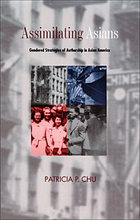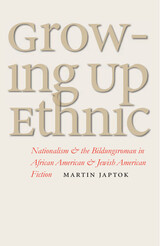4 books about Bildungsroman

Assimilating Asians
Gendered Strategies of Authorship in Asian America
Patricia P. Chu
Duke University Press, 2000
One of the central tasks of Asian American literature, argues Patricia P. Chu, has been to construct Asian American identities in the face of existing, and often contradictory, ideas about what it means to be an American. Chu examines the model of the Anglo-American bildungsroman and shows how Asian American writers have adapted it to express their troubled and unstable position in the United States. By aligning themselves with U.S. democratic ideals while also questioning the historical realities of exclusion, internment, and discrimination, Asian American authors, contends Chu, do two kinds of ideological work: they claim Americanness for Asian Americans, and they create accounts of Asian ethnicity that deploy their specific cultures and histories to challenge established notions of Americanness.
Chu further demonstrates that Asian American male and female writers engage different strategies in the struggle to adapt, reflecting their particular, gender-based relationships to immigration, work, and cultural representation. While offering fresh perspectives on the well-known writings—both fiction and memoir—of Maxine Hong Kingston, Amy Tan, Bharati Mukherjee, Frank Chin, and David Mura, Assimilating Asians also provides new insight into the work of less recognized but nevertheless important writers like Carlos Bulosan, Edith Eaton, Younghill Kang, Milton Murayama, and John Okada. As she explores this expansive range of texts—published over the course of the last century by authors of Chinese, Japanese, Korean, Filipino, and Indian origin or descent—Chu is able to illuminate her argument by linking it to key historical and cultural events.
Assimilating Asians makes an important contribution to the fields of Asian American, American, and women’s studies. Scholars of Asian American literature and culture, as well as of ethnicity and assimilation, will find particular interest and value in this book.
Chu further demonstrates that Asian American male and female writers engage different strategies in the struggle to adapt, reflecting their particular, gender-based relationships to immigration, work, and cultural representation. While offering fresh perspectives on the well-known writings—both fiction and memoir—of Maxine Hong Kingston, Amy Tan, Bharati Mukherjee, Frank Chin, and David Mura, Assimilating Asians also provides new insight into the work of less recognized but nevertheless important writers like Carlos Bulosan, Edith Eaton, Younghill Kang, Milton Murayama, and John Okada. As she explores this expansive range of texts—published over the course of the last century by authors of Chinese, Japanese, Korean, Filipino, and Indian origin or descent—Chu is able to illuminate her argument by linking it to key historical and cultural events.
Assimilating Asians makes an important contribution to the fields of Asian American, American, and women’s studies. Scholars of Asian American literature and culture, as well as of ethnicity and assimilation, will find particular interest and value in this book.
[more]

Growing Up Ethnic
Nationalism and the Bildungsroman in African American and Jewish American Fiction
Martin Japtok
University of Iowa Press
Growing Up Ethnic examines the presence of literary similarities between African American and Jewish American coming-of-age stories in the first half of the twentieth century; often these similarities exceed what could be explained by sociohistorical correspondences alone. Martin Japtok argues that these similarities result from the way both African American and Jewish American authors have conceptualized their "ethnic situation." The issue of "race" and its social repercussions certainly defy any easy comparisons. However, the fact that the ethnic situations are far from identical in the case of these two groups only highlights the striking thematic correspondences in how a number of African American and Jewish American coming-of-age stories construct ethnicity. Japtok studies three pairs of novels--James Weldon Johnson's Autobiography of an Ex-Coloured Man and Samuel Ornitz's Haunch, Paunch and Jowl, Jessie Fauset's Plum Bun and Edna Ferber's Fanny Herself, and Paule Marshall's Brown Girl, Brownstones and Anzia Yezierska's Bread Giver--and argues that the similarities can be explained with reference to mainly two factors, ultimately intertwined: cultural nationalism and the Bildungsroman genre. Growing Up Ethnic shows that the parallel configurations in the novels, which often see ethnicity in terms of spirituality, as inherent artistic ability, and as communal responsibility, are rooted in nationalist ideology. However, due to the authors' generic choice--the Bildungsroman--the tendency to view ethnicity through the rhetorical lens of communalism and spiritual essence runs head-on into the individualist assumptions of the protagonist-centered Bildungsroman. The negotiations between these ideological counterpoints characterize the novels and reflect and refract the intellectual ferment of their time. This fresh look at ethnic American literatures in the context of cultural nationalism and the Bildungsroman will be of great interest to students and scholars of literary and race studies.
[more]

Season of Youth
The Bildungsroman from Dickens to Golding
Jerome H. Buckley
Harvard University Press, 1974

Young China
National Rejuvenation and the Bildungsroman, 1900–1959
Mingwei Song
Harvard University Press, 2015
The rise of youth is among the most dramatic stories of modern China. Since the last years of the Qing dynasty, youth has been made a new agent of history in Chinese intellectuals’ visions of national rejuvenation through such tremendously popular notions as “young China” and “new youth.” The characterization of a young protagonist with a developmental story has also shaped the modern Chinese novel. Young China takes youth as a central literary motif that was profoundly related to the ideas of nationhood and modernity in twentieth-century China. A synthesis of narrative theory and cultural history, it combines historical investigations of the origin and development of the modern Chinese youth discourse with close analyses of the novelistic construction of the Chinese Bildungsroman, which depicts the psychological growth of youth with a symbolic allusion to national rejuvenation. Negotiating between self and society, ideal and action, and form and reality, such a narrative manifests as well as complicates the various political and cultural symbolisms invested in youth through different periods of modern Chinese history. In this story of young China, the restless, elusive, and protean image of youth both perpetuates and problematizes the ideals of national rejuvenation.
[more]
READERS
Browse our collection.
PUBLISHERS
See BiblioVault's publisher services.
STUDENT SERVICES
Files for college accessibility offices.
UChicago Accessibility Resources
home | accessibility | search | about | contact us
BiblioVault ® 2001 - 2024
The University of Chicago Press









